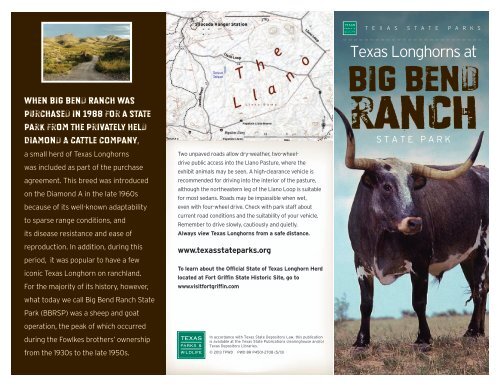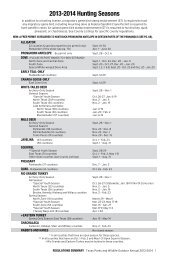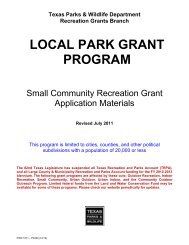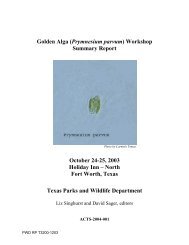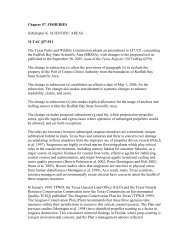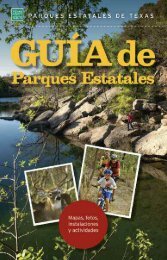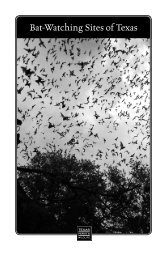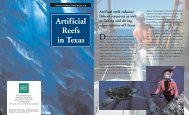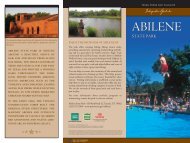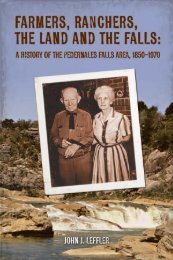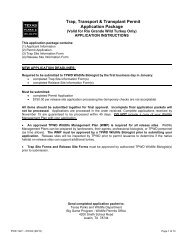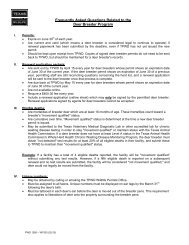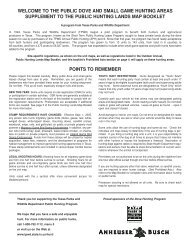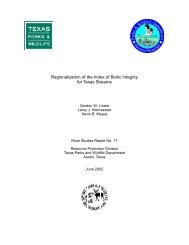Texas Longhorns at Big Bend Ranch State Park
Texas Longhorns at Big Bend Ranch State Park
Texas Longhorns at Big Bend Ranch State Park
Create successful ePaper yourself
Turn your PDF publications into a flip-book with our unique Google optimized e-Paper software.
T E X A S S T A T E P A R K S<br />
When <strong>Big</strong> <strong>Bend</strong> <strong>Ranch</strong> was<br />
purchased in 1988 for a st<strong>at</strong>e<br />
park from the priv<strong>at</strong>ely held<br />
Diamond A C<strong>at</strong>tle Company,<br />
a small herd of <strong>Texas</strong> <strong>Longhorns</strong><br />
was included as part of the purchase<br />
agreement. This breed was introduced<br />
on the Diamond A in the l<strong>at</strong>e 1960s<br />
because of its well-known adaptability<br />
to sparse range conditions, and<br />
its disease resistance and ease of<br />
reproduction. In addition, during this<br />
period, it was popular to have a few<br />
iconic <strong>Texas</strong> Longhorn on ranchland.<br />
For the majority of its history, however,<br />
wh<strong>at</strong> today we call <strong>Big</strong> <strong>Bend</strong> <strong>Ranch</strong> St<strong>at</strong>e<br />
<strong>Park</strong> (BBRSP) was a sheep and go<strong>at</strong><br />
oper<strong>at</strong>ion, the peak of which occurred<br />
during the Fowlkes brothers’ ownership<br />
from the 1930s to the l<strong>at</strong>e 1950s.<br />
Two unpaved roads allow dry-we<strong>at</strong>her, two-wheeldrive<br />
public access into the Llano Pasture, where the<br />
exhibit animals may be seen. A high-clearance vehicle is<br />
recommended for driving into the interior of the pasture,<br />
although the northeastern leg of the Llano Loop is suitable<br />
for most sedans. Roads may be impassible when wet,<br />
even with four-wheel drive. Check with park staff about<br />
current road conditions and the suitability of your vehicle.<br />
Remember to drive slowly, cautiously and quietly.<br />
Always view <strong>Texas</strong> <strong>Longhorns</strong> from a safe distance.<br />
www.texasst<strong>at</strong>eparks.org<br />
To learn about the Official St<strong>at</strong>e of <strong>Texas</strong> Longhorn Herd<br />
loc<strong>at</strong>ed <strong>at</strong> Fort Griffin St<strong>at</strong>e Historic Site, go to<br />
www.visitfortgriffin.com<br />
In accordance with <strong>Texas</strong> St<strong>at</strong>e Depository Law, this public<strong>at</strong>ion<br />
is available <strong>at</strong> the <strong>Texas</strong> St<strong>at</strong>e Public<strong>at</strong>ions clearinghouse and/or<br />
<strong>Texas</strong> Depository Libraries.<br />
© 2013 TPWD PWD BR P4501-2708 (5/13)<br />
<strong>Texas</strong> <strong>Longhorns</strong> <strong>at</strong><br />
<strong>Big</strong> bend<br />
ranch<br />
STATE PARK
TEXAS LONGHORN LEGACY<br />
Accounts from travelers crossing <strong>Texas</strong> in the early 1700s include stories of the presence of many<br />
wild c<strong>at</strong>tle, often misidentified as n<strong>at</strong>ive species. Free-range longhorns were considered game,<br />
much like deer and buffalo, but were regarded as very wild and even more difficult to hunt. Initially<br />
referred to as “<strong>Texas</strong> c<strong>at</strong>tle” and, l<strong>at</strong>er, <strong>Texas</strong> <strong>Longhorns</strong>, the animals popul<strong>at</strong>ed a widespread area<br />
by the time <strong>Texas</strong> won its independence from Mexico in 1836. At th<strong>at</strong> time they ranged from the Red<br />
River to the Rio Grande, east to the Louisiana line and west to the upper breaks of the Brazos River.<br />
These early longhorns continued to roam <strong>Texas</strong>, almost completely wild until the end of the Civil War.<br />
The Gre<strong>at</strong> C<strong>at</strong>tle Drives<br />
After the Civil War, <strong>Texas</strong> veterans<br />
returned home to a poor st<strong>at</strong>e and<br />
devast<strong>at</strong>ed economy, but they had<br />
access to a boundless marketable<br />
commodity—millions of wild longhorn c<strong>at</strong>tle. However,<br />
the distance and transport<strong>at</strong>ion northward to beefstarved<br />
markets presented a challenge. Thus arose<br />
the overland c<strong>at</strong>tle drives via the famous c<strong>at</strong>tle trails<br />
including the Western, Chisholm, and the Goodnight-<br />
Loving trails to the gre<strong>at</strong> rail yards in Kansas, Wyoming,<br />
and other northern st<strong>at</strong>es.<br />
The End of an Era<br />
By the early 1900s, the longhorn was regarded as a<br />
less desirable breed of c<strong>at</strong>tle. Rail access improved,<br />
barbed wire closed the open range, trail drives become<br />
memories, and beef c<strong>at</strong>tle were no longer being<br />
transported to faraway markets. European breeds th<strong>at</strong><br />
yielded more beef per animal became more popular,<br />
and the number of longhorns decreased.<br />
<strong>Texas</strong> Conserv<strong>at</strong>ion Efforts<br />
Western writer J. Frank Dobie recognized the decline<br />
of the <strong>Texas</strong> Longhorn in the early 1920s and felt it was<br />
important to preserve the breed th<strong>at</strong> held such a significant<br />
place in <strong>Texas</strong> history. With assistance from businessman<br />
Sid Richardson and rancher Graves Peeler, Dobie helped<br />
organize a herd of typical longhorns. The animals were<br />
don<strong>at</strong>ed to the <strong>Texas</strong> <strong>Park</strong>s Board in 1941 as the st<strong>at</strong>e herd,<br />
and were kept <strong>at</strong> Lake Corpus Christi St<strong>at</strong>e <strong>Park</strong> near<br />
M<strong>at</strong>his. Since they were becoming more scarce, the search<br />
continued for longhorns, and in 1942 a herd was compiled<br />
and kept <strong>at</strong> Lake Brownwood St<strong>at</strong>e <strong>Park</strong> in Brown County.<br />
Due to challenges <strong>at</strong> these loc<strong>at</strong>ions, the <strong>Texas</strong> St<strong>at</strong>e <strong>Park</strong>s<br />
Board began looking for a more permanent home for<br />
the herd. Fort Griffin St<strong>at</strong>e <strong>Park</strong> (now the <strong>Texas</strong> Historical<br />
Commission’s Fort Griffin St<strong>at</strong>e Historic Site) was selected<br />
as the permanent home in 1948, and the official herd has<br />
been based there ever since. The Official St<strong>at</strong>e of <strong>Texas</strong><br />
Longhorn Herd is now jointly managed by the THC and<br />
<strong>Texas</strong> St<strong>at</strong>e <strong>Park</strong>s, with part of the herd being retained <strong>at</strong><br />
San Angelo St<strong>at</strong>e <strong>Park</strong>.<br />
BBRSP retains a few longhorns<br />
in the park for visitors to view.<br />
The c<strong>at</strong>tle you can observe today in the Llano<br />
Pasture represent true-to-type <strong>Texas</strong> <strong>Longhorns</strong><br />
and provide examples of the highly variable<br />
color<strong>at</strong>ion and p<strong>at</strong>terns th<strong>at</strong> occur within the<br />
breed. In the words of J. Frank Dobie, <strong>Texas</strong><br />
<strong>Longhorns</strong> are “more varied than the colors<br />
of the rainbow.” The roans, brindles, speckled<br />
p<strong>at</strong>terns, linebacks, grullas, reds, yellows,<br />
oranges, browns, and blacks come from varying<br />
amounts and p<strong>at</strong>terns of only two pigments—<br />
red and black—on different parts of the body.<br />
The characteristic horns for which the breed<br />
was named can extend to seven feet tip-to-tip in<br />
steers. Some horns have a slight upward turn <strong>at</strong><br />
their tips, occasionally with up to three twists.


